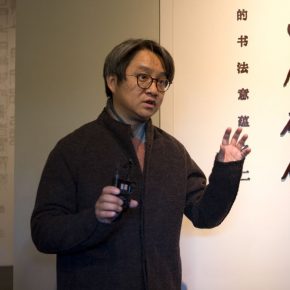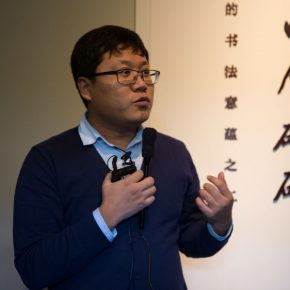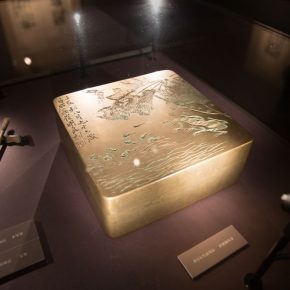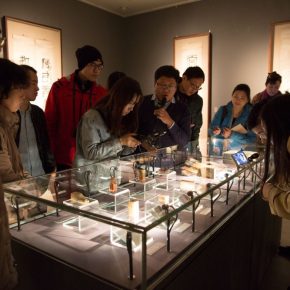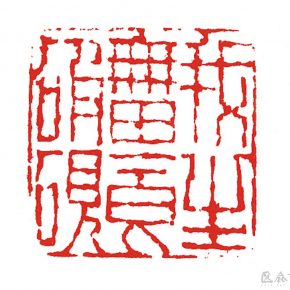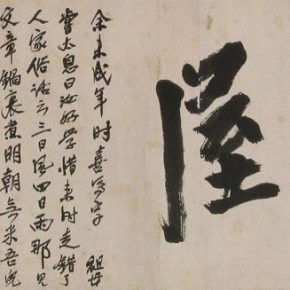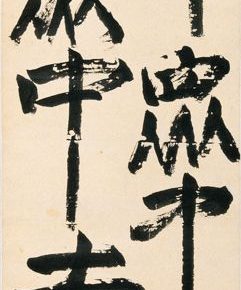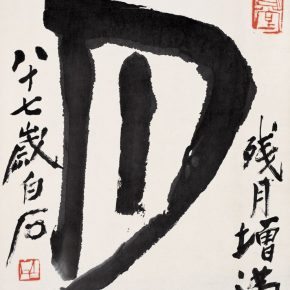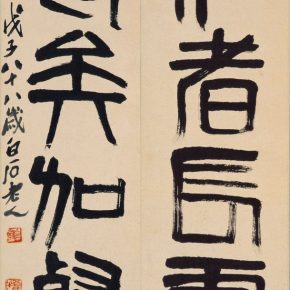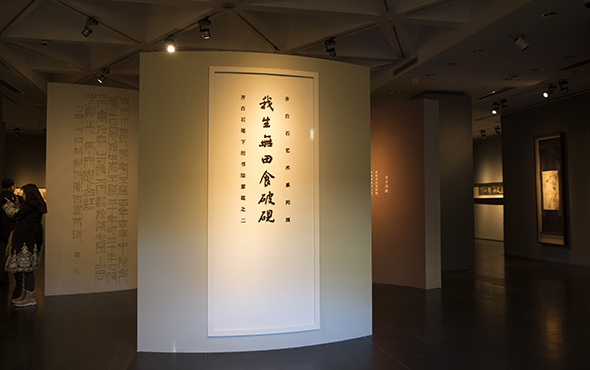
On the afternoon of December 22, 2017, a special exhibition entitled “Living by Selling Texts Instead of Farming – Qi Baishi’s Calligraphic Implication II” opened at the Art Museum of Beijing Fine Art Academy. The exhibition was organized by Beijing Fine Art Academy, in cooperation with CAFA, Liaoning Provincial Museum, Hunan Provincial Museum, Capital Museum and the China Three Gorges Museum in Chongqing, bringing together more than 60 sets of selected works by Qi Baishi from the collections of the 6 organizations that collect works by Qi Baishi, in China, to trace the development and evolution of Qi Baishi’s Chinese calligraphy, meanwhile it is an excellent opportunity for the audience to understand and appreciate the evolution of Qi Baishi’s calligraphy art.
Wu Hongliang, Director of the Art Museum of Beijing Fine Art Academy, said: “This exhibition is not confined to the collections of Beijing Fine Art Academy, but seeks a more extensive cooperation with major domestic organizations with collections?and borrowing of works on the basis of different themes, in order to fully present the developmental context of Qi Baishi’s art, so that scholars and audiences can more fully understand and appreciate the greatest value and charm of Qi Baishi’s art”. Xue Liang, the curator of the exhibition and Director of the Exhibition Department of the Art Museum of Beijing Fine Art Academy, introduced the basic overview of the exhibition, which is divided into 4 parts, including “Copying the Ancient and Modern Masterpieces”, “Boldly Creating”, “Directly Writing with Their Own Ideas”, and “Constant Creation and Evolution”.
Living by Selling Texts Instead of Farming ???
“Living by selling texts instead of farming” is a sentence diverted from the ancient poet Su Dongpo’s poem. Qi Baishi (1 January 1864 – 16 September 1957) was a?Chinese painter, born into?a poor peasant family from?Xiangtan,?Hunan. Qi became a carpenter at the age of 14, and learned to paint by himself. Qi Baishi started receiving artistic training from Hu Qinyuan, when he was 27 years old, and then realized that he could pursue art as his full-time career, so he became dedicated to engraving seals and painting, becoming a professional painter.
It features two pieces of “Zeng House”, which are representative of the calligraphic works of cursive handwriting by Qi Baishi during the period of the “Reform of Old Age”, and “Zeng” was also one of the names of Qi Baishi’s house. Zeng was one of the cooking utensils in ancient China to steam food.?Qi Baishi meant he was through selling paintings and calligraphy to feed his family, so the studio was named “Zeng House”. In the social environment of farming in the late Qing Dynasty, Qi Baishi was born into a poor peasant family, he did not deal with the crops in the ground in accordance with his fate. Instead, he became one of the greatest artists in China in the twentieth century with his efforts and opportunities, he created an extraordinary life using his brush?and knife.
Good at Using Last Night’s Ink ?
“Qi Baishi’s early calligraphy was from the official way of lettering, and he started to study the chirography of calligrapher He Shaoji from Hunan of the Qing Dynasty, under the influence of his teacher Hu Qinyuan”, curator Xue Liang introduced the experiences of Qi Baishi learning from teachers, “with the development of far-sighted eyes and the change of style during the ‘Reform of Old Age’, Qi Baishi gradually learned from Jin Nong’s regular script, Li Yong’s running hand, seal character of Han steles, as well as the calligraphy of the Shanghai School, he gradually developed an artistic road of “being away from the ancient after learning from the ancient”, and eventually formed an unique style of calligraphy.
Qi Baishi was good at running hand and seal characters. His running hand was mostly used in the writing of inscriptions and postscripts, as well as daily writing. The exhibited works cover running hand, seal character, clerical script, and regular script, and the contents are about modern life, such as “Come from the Masses and Return to the Masses”, collected by CAFA Art Museum, was specially created by Qi Baishi at the age of 90, in order to celebrate the establishment of CAFA, from the changes of script we can see that he was still copying calligraphy daily in the later years of life, and striving to change the style of writing.
“Li Kuchan and Li Keran, Students of Qi Baishi” Offered Ancient Collections??
Li Kuchan and Li Keran were masters of Chinese painting, and also students of Qi Baishi. Under the guidance of Qi Baishi who warned that “Learning from me you will succeed, but copying me you will fail.” Although both masers established their own schools in modern painting circles, with a far-reaching impact, their artistic styles and aesthetic tastes were very different. In the exhibition, Li Kuchan and Li Keran’s old collections are also on show, which support the calligraphic exhibition of their teacher through another way. Li Kuchan’s old collections of the rubbings of “Zheng Wengong’s Monument” and “Stele of God's Prophecy” had a significant impact on Qi Baishi’s works of calligraphy and seal cutting. The two monuments reveal the inheritance between the two masters of flowers and birds, and also show the two Chinese painters’ attitude of learning traditional culture.
During the special exhibition of Qi Baishi’s calligraphy, the exhibition of “He Shaoji’s Calligraphy and the Inheritance & Context of Hunan” is also held on the third and fourth floor exhibition halls of the Art Museum of Beijing Fine Art Academy. Both exhibitions echo each other, and the audience can appreciate the inheritance and charm of modern Hunan culture at the same time. “Living by Selling Texts Instead of Farming – Qi Baishi’s Calligraphic Implication II” is the last show launched by Beijing Fine Art Academy in 2017, featuring the excellent calligraphy of Qi Baishi and sifting of the evolution using a calligraphic context, showing the concrete academic value and special artistic experience. The exhibition remains on view till February 28, 2018.
Photo and text edited by Zhang Yizhi (photos of the works courtesy of the organizers)/CAFA ART INFO
Translated by Chen Peihua and edited by Sue/CAFA ART INFO


